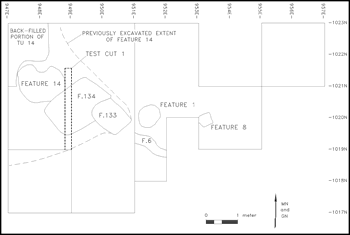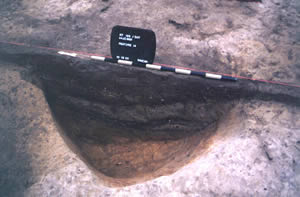Structure 4
 Evidence of Structure 4 at Site 44JC969 was discovered very late in the data recovery investigations about 30 ft. west of Structure 2 in the northern portion of the occupation area. Due to the presence of large trees and budget and time constraints, only limited archaeological information could be recovered from the locus of Structure 4. Features associated with Structure 4 included two rectangular subfloor pits and a broad cultural deposit that sealed the two pits and filled shallow subfloor depressions adjacent to the pits. The relationship between the pit features and the overlying cultural deposit was very similar to the assemblage of pit features and a blanketing cultural deposit found in nearby Structure 2, though Structure 4 was represented by only two pit features in contrast to the nine pits found in Structure 2. The pits in Structure 4 were oriented on the same alignment as those in Structures 1 and 2. Like those in Structure 2, one of the Structure 4 pits overlapped the other such that it apparently had been dug partly into the backfill of a previously used and filled pit. The earliest pit was found to be the deepest of all the subfloor pits discovered at the site, with fill containing burned animal bone, charcoal, and food preparation artifacts alternating with layers of relatively sterile sand. Though the fill of this large pit suggested proximity to a cooking hearth, no evidence of such a hearth was identified immediately adjacent to the pit features. Diagnostic artifacts recovered from the two pits include wine bottles dating to the 1760s to 1770s and several sherds of creamware. No pearlware sherds were recovered.
Evidence of Structure 4 at Site 44JC969 was discovered very late in the data recovery investigations about 30 ft. west of Structure 2 in the northern portion of the occupation area. Due to the presence of large trees and budget and time constraints, only limited archaeological information could be recovered from the locus of Structure 4. Features associated with Structure 4 included two rectangular subfloor pits and a broad cultural deposit that sealed the two pits and filled shallow subfloor depressions adjacent to the pits. The relationship between the pit features and the overlying cultural deposit was very similar to the assemblage of pit features and a blanketing cultural deposit found in nearby Structure 2, though Structure 4 was represented by only two pit features in contrast to the nine pits found in Structure 2. The pits in Structure 4 were oriented on the same alignment as those in Structures 1 and 2. Like those in Structure 2, one of the Structure 4 pits overlapped the other such that it apparently had been dug partly into the backfill of a previously used and filled pit. The earliest pit was found to be the deepest of all the subfloor pits discovered at the site, with fill containing burned animal bone, charcoal, and food preparation artifacts alternating with layers of relatively sterile sand. Though the fill of this large pit suggested proximity to a cooking hearth, no evidence of such a hearth was identified immediately adjacent to the pit features. Diagnostic artifacts recovered from the two pits include wine bottles dating to the 1760s to 1770s and several sherds of creamware. No pearlware sherds were recovered.
 Since much of the area surrounding the two subfloor pit features was not fully exposed, it was not possible to determine conclusively whether Structure 4 was of earthfast construction (with wooden structural supports sunk into the ground) like nearby Structure 2 or built entirely above-ground as a log structure similar to the interpreted construction of Structures 1 and 3. Structure 4 and nearby Structure 2 may represent an earlier occupation than the southern portion of the excavation area around Structures 1 and 3, where later pearlware ceramics were clustered. If Structures 4 and 2 are roughly contemporeous, they may have shared the same earthfast construction.
Since much of the area surrounding the two subfloor pit features was not fully exposed, it was not possible to determine conclusively whether Structure 4 was of earthfast construction (with wooden structural supports sunk into the ground) like nearby Structure 2 or built entirely above-ground as a log structure similar to the interpreted construction of Structures 1 and 3. Structure 4 and nearby Structure 2 may represent an earlier occupation than the southern portion of the excavation area around Structures 1 and 3, where later pearlware ceramics were clustered. If Structures 4 and 2 are roughly contemporeous, they may have shared the same earthfast construction.
 Skip to main content
Skip to main content
